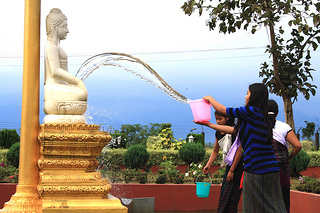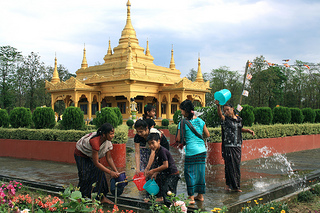This video features Sangken, the traditional festival of water marking symbolic purification before the new year in Arunachal Pradesh.
It is a socio-religious festival and traditional culture of the Khamti tribe of Lohit district of Arunachal Pradesh. During the celebration, images of Lord Buddha are bathed with holy water ceremoniously. This festival also marks the New Year and Khamti people throw water on each other as a sign of happiness.
Sangken is generally known as the ‘Festival of Water’. It is because the obvious sight during the festival is people pouring water at one another. This practice is part of the cleansing ritual to welcome the New Year by the Khamtis.
Traditionally, people gently sprinkled water on one another as a sign of respect. The act of pouring water is also a show of blessings and good wishes. It is believed that on this Water Festival, everything old must be thrown away, or it will bring the owner bad luck. Khamptis believe, in this New Year, water will be the savior.
The festival is also celebrated by Singpho, Khamyang, Tikhaks (Tangsa) and Phakyal community of Arunachal Pradesh and generally falls in the month of ‘Naun-ha’ of Khamti calendar and corresponds to the Sankranti of Baisakh. A socio-religious festival of the Theravada sect of Buddhism, it is celebrated to welcome the new year, which falls generally from 13th to 15th April. The word Sang ken is literally derived from the Sanskrit word ‘Sankranti’. The festival is also celebrated in countries like Myanmar, Thailand, Laos and Cambodia.

People pouring water on the Buddha to seek protection of the mankind from evils
The celebration and rituals
On the day of the Sangken, the idols of Lord Buddha are brought out from Vihara (temple) to Kyongfra, a temporary shrine. The blessing of Lord is invoked by sprinkling clean water over the idols and pouring water to the rope of the Dharma and Sangha that forms the three jewels of Buddhism. Prayers are arranged during the celebration. People come out in new and colorful costumes to observe Sangken, the festival of water for peace and harmony.
The most obvious way of celebrating Sangken is by throwing water. Khamti unmarried youths roam the streets with buckets of water and drench each other and passersby. The elderly and married people generally don’t involve in this practice.
For preparations of the festival, Kyongfra, a temporary shrine for keeping the idols of Buddha during Sangken is constructed with bamboo and toko leaves. It is then decorated with flowers and paper. In this Kyongfra, clean water is sprinkled through the ‘Lungkong’, a water fountain which is connected to ‘Hoelin’, a boatshaped wooden structure. Water poured on the ‘Hoelin’ rushes to the Lungkong with mild pressure and causes a rotary movement to the Lungkong. With this rotary movement, clean and scented water is sprinkled over the idols kept inside the Kyongfra.
Clean and scented water is also sprinkled on the idols of Buddha kept in special platforms. Water is also poured on the Bodhi tree, the Sailik (ropes of holy books) and all other holy objects. The devotees pour water on the hands of the Bhikkhus (monks) seeking blessings. Water is also poured over the feet and hands of the elderly people for blessings.

Wishing happy new year by splashing water
People enjoy and make fun during the festival by throwing water on each other. Similar to ‘Holy’ festival celebrated in other parts of the country, but no colour is used here. This festival is celebrated for three days and people exchange gifts and sweets.
Sangken is a festival to invoke the blessings of the lord Buddha for protection of the mankind from the evils, for peace, harmony, good luck and good health. At the end of the celebration, which lasts for three days, the idols of Lord Buddha are taken back to the Viharas (temples). Restoration of idols inside the Vihara marks the end of the old year and beginning of the New Year.
View more pictures of "Sangken-The festival of water in Arunachal Pradesh" on Flickr